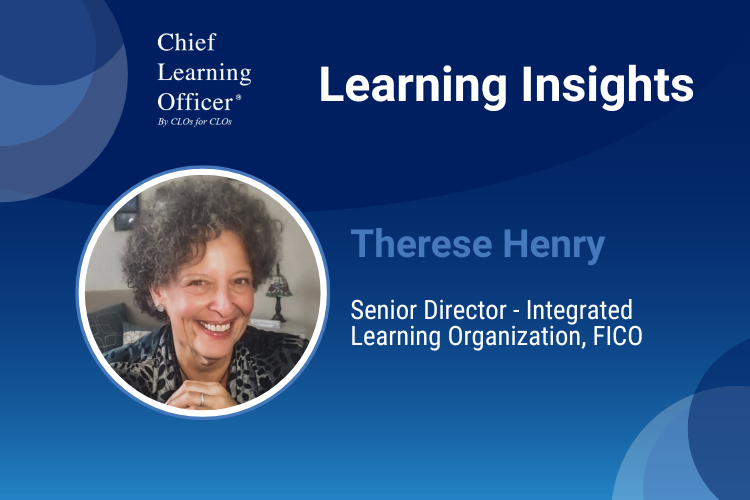Chief Learning Officer’s “Learning Insights” series is dedicated to showcasing the thoughts and career journeys of chief learning officers and learning executives — the tireless trailblazers who are transforming the landscape of corporate learning and workforce development. In this Q&A series, we garner strategic insights, innovative approaches and challenges overcome from visionary leaders worldwide.
What initially drew you to a career in learning and development, and how have your experiences evolved over the years?
After spending more than 30 years in the corporate world in positions ranging from technology to sales, I found my way to L&D in the last two years. Our organization along with an outside vendor, Coachability, began a women’s leadership group and I had the honor of being part of the initial pilot program. After completing the program, I wanted to create a “pay it forward” mentoring program for women. The program was created and rolled out in the women’s leadership program and eventually to the entire global organization, including both men and women from around the globe. It was a round-about way to L&D and it has been a labor of love!
What key initiatives have you implemented as a learning leader to drive employee development and foster a learning culture?
I designed and rolled out a global mentoring program for our organization with the goal of developing the leadership pipeline. I’ve been a participant in mentoring programs in the past and the biggest gap for me was the lack of intentionality in the design and implementation. I brought that learning to our program and designed it to include enablement sessions for mentors—helping them learn and practice the skills needed to be successful—and for mentees—helping them prepare for the mentoring engagement, providing them guidance on goal setting, mindset and roles and responsibilities.
Throughout the six-month active mentoring engagement between the mentor and mentee, there are workshops to support the participants. There are also assessments that measure the enablement sessions, matching success and program value. All assessments are used to improve the program from cohort to cohort. The program was designed to be sustainable over time and there is ongoing demand for the program across the globe.
What is the most impactful learning program you’ve introduced in your organization, and how has it contributed to employee growth and business success?
The global mentoring program that I introduced was the first globally managed formal mentoring program at our organization. Once it was successful, partner programs such as peer mentoring for our technical teams and reverse mentoring for our employee resource groups were launched. The success of the initial mentoring program is measurable. Participants displayed significant learning gain over the course of the enablement with learning gain ranging from 35-50 percent. Learning transfer from an application to relevancy scored very high with the majority of responses categorized as extremely likely to use the information or extremely relevant to the mentoring process. Additionally, although we are only in our third six-month cohort, we have seen a reduction in attrition for those involved versus those who did not participate, and a higher likelihood of promotion or career movement.
What is a common misconception people might have about the L&D function, and how do you address it?
The most common misconception I have heard is that people do not have time for L&D and I address this in one of my workshops related to mindset. As part of a breakout group activity, we look at “I don’t have time for L&D” as a limiting belief and then work through how to challenge that limiting belief. I have found that I can explain why L&D is important but it is much more persuasive when each individual works through this belief and comes to their own conclusions, guided by a limiting beliefs worksheet.
What excites you the most about the future of workplace learning, and how are you preparing your organization to adapt to the changing landscape?
There was a time when leadership skills were thought of as a “nice to have” and not a requirement. I am excited to see how my organization and many others are embracing the need to help their employees develop, learn and grow. What was once called a “soft skill” is now viewed as a necessary skill for advancement. At our annual conference, FICO® World, we have a Business Culture Track focused on development and growth. It is exciting to see other conferences also do this.
What essential qualities or skills make a successful L&D leader, and how do you cultivate these traits in yourself and among your team?
The most important quality or skill is caring. To be successful, an L&D leader must care about the organization, the team and themselves. Another important quality is self-awareness. I have seen firsthand among leaders from diverse backgrounds the inability to believe in themselves. Helping others understand their personal superpower is a passion of mine and I have seen so much growth in people once they find that thing that makes them special. It helps them leave behind their fear and embrace their power. My favorite quote from Marianne Williamson really tells the story: “Our deepest fear is not that we are inadequate. Our deepest fear is that we are powerful beyond measure.”
What game-changing advice would you offer if you could go back in time and mentor your younger self?
This question really made me think. I started my career as an overweight, insecure woman who just wanted to fit in and be the best. What that often meant is that I tried to be someone else instead of accepting myself and my strengths. If I could go back and mentor my younger self, I would lovingly tell her that it is OK to be true to who you are and that truth will help you succeed at work and in life.
What do you feel is currently the single biggest challenge facing L&D professionals and the industry as a whole?
The biggest challenge in the industry is that leaders within organizations don’t always prioritize L&D. When leaders understand the importance of L&D from a revenue, employee engagement and retention perspective, that challenge is mitigated.
We’re always looking to showcase innovative tools and technologies. Can you share one work or learning tech product or platform that has significantly improved your work processes and why you find it valuable?
I am always looking for new tools and technologies to help with work processes. Although we use a number of different tech products, I have yet to find the one that really fits.
FICO is a registered trademark of Fair Isaac Corporation in the U.S. and other countries.
Interested in being featured in our “Learning Insights” series? Please complete this FORM.















